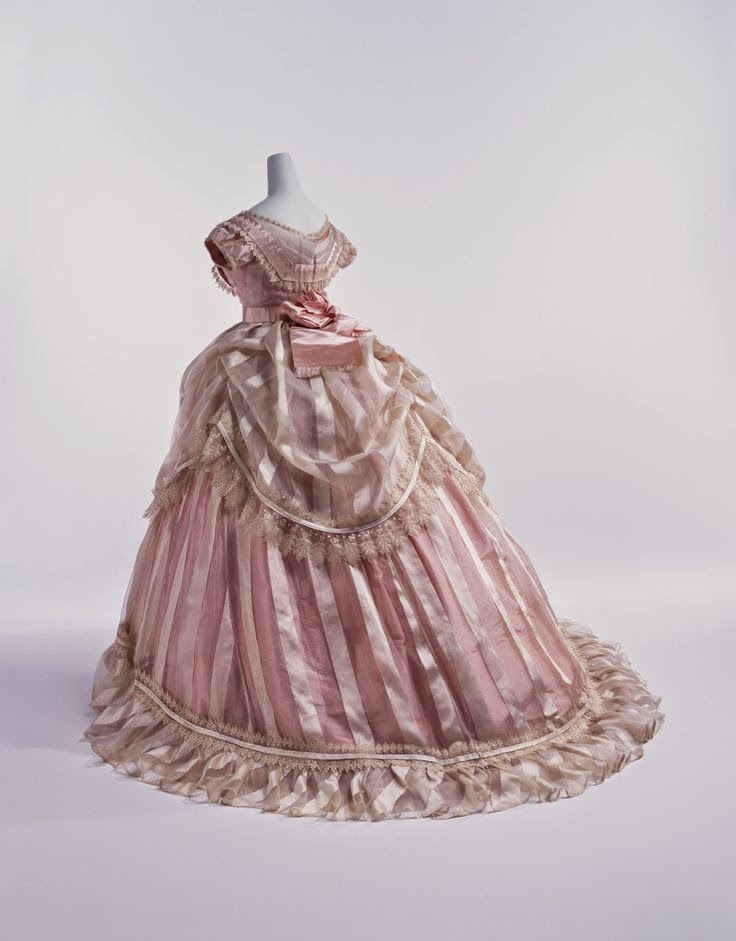To start, I would like to say that I do not know how historically accurate this method is. I know some bustles had tie tapes on the inside and others have the flat panels (which this is an adaption of), but you just don't see the inside of that many bustles - outside of the wire ones - to know what the heck is going on in there. I know that the Laughing Moon Patterns uses a similar method for their bustles, but there are no notes about authenticity in the pattern packet.
For the adaption, you'll need grommets (I use size 00), a grommet setting device, 1/4" white steel boning or industrial size plastic zip ties, and 2-3 yards of lacing ribbon.
To begin, take the inner support panel from your bustle pattern and mark the exact center.
From the center, add 1 3/4" and mark this new spot.
Now this is the tricky part. You must change the pattern piece to allow for a gap between the two panel pieces once they are laced together. Depending on how much of a gap you want, this will affect your next measurement. For a 1" gap, measure 1/2" from the center. For a 2" gap, measure 1" from the center. Just remember that whatever measurement you choose, it will double the actual gap between the panels.
I DO NOT RECOMMEND LEAVING OUT THIS CENTER GAP SINCE IT DOES NOT ALLOW FOR THE PANEL TO BE ADJUSTED ONCE TIED.
Once you've selected the size of your panel gap, move your center line to this spot, making sure to also move the added 1 3/4" on the side. This is your new pattern piece. To retain the original, trace over it using pattern paper or my personal favorite - wax paper.
Cut two pieces from the pattern, one for each side of the panel. Start by zig-zagging, overlocking, or serging the top and bottom edges of the panel pieces.
Along the center, fold the fabric over 1/4" and iron. Fold over an additional 1 1/2" and iron again. All folds should be made toward the inside, meaning the inner area of the bustle.
Pin the material in place and stitch 1/8" from the inner edge, then stitch 1/2" from the outside edge. This creates the boning and grommet channels.
Fold up the bottom 1/2 " edge of the panel to the inside, iron, then stitch along overlocked edge.
Repeat these steps on the other panel piece.
With both panel pieces, place them side by side and space out the grommets along the grommet channel (this is the wider one at about 1"). Keep in mind that the top of the panel piece will also be folded over 1/2" as well. My spacing recommendation is about 1"-1 1/4" between each grommet. Mark then attach the grommets using your preferred method.
Once the grommets have been set, take the white steel boning or industrial zip ties and measure then cut them to fit the length of the boning channel. For the zip ties, round and smooth the tips to keep them from poking through the material.
Insert into the channel, fold over 1/2" toward the inside and stitch in place the top of the panel pieces.
This forms your two panel pieces which you sew into the seams following your regular sewing instructions. Once the bustle is finished, lace the panels together as closely as you desire. When you are ready to store the bustle, simply unlace it.
For larger bustles, you may choose to make two sets of panels to be laced and adjusted separately.
NOTE: Red fabric is from my 1880s Bustle, and purple fabric is from my early 1870s bustle. Some of the photos taken were easier to do with the red bustle.
* * *
Feel free to leave any questions you might have and I hope this proves helpful for your bustle projects!




























+Website.jpg)


